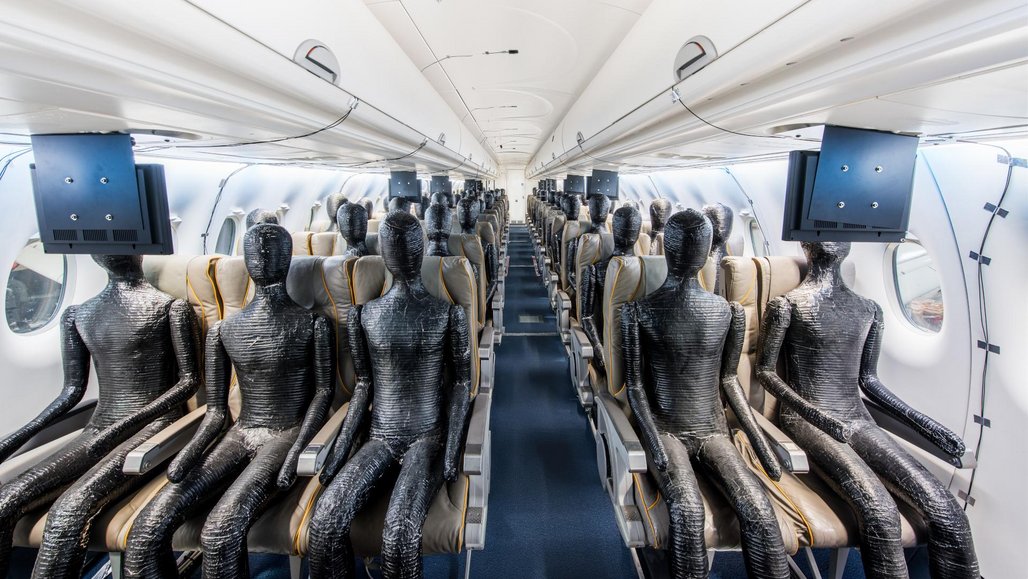Modes of transport such as planes and trains underpin mass mobility in the modern age. However, they are also suspected of facilitating the spread of the Coronavirus. But how do virus particles actually spread within passenger compartments? And how is this affected by ventilation? This is currently under investigation at the German Aerospace Center (Deutsches Zentrum für Luft- und Raumfahrt; DLR). The findings may help to better understand the challenges facing mobility during the COVID-19 pandemic and thus contribute towards finding solutions.
What is being investigated?
Researchers at the DLR site in Göttingen are investigating the spread of potentially virus-laden droplets in trains and aircraft, both through experiments and computer simulations. The researchers first introduce a 'sick' passenger into a fully occupied area. They then look at how far exhaled particles are distributed.
How is this being studied?
The researchers are using a computer to simulate a section of an open-plan train compartment with six rows of seats. The 'sick' passenger's exhalation or coughing pattern is generated using a program that has long been used to successfully simulate cabin airflow. This is supplemented by the addition of aerosol particles, which then atomise and evaporate. For coughing, the atomisation process has clear parallels with the process of fuel injection into an engine, where strong shear forces cause the droplets to disintegrate. The parameters used, such as the exhaled lung volume (approximately one to 1.5 litres) and the size of the droplets, which range from smaller than one micrometre to several hundreds of micrometres, are derived from studies conducted by the US Federal Aviation Authority (FAA). The computer program calculates the distribution and range of the particles and provides a graphical representation of their propagation.
At the same time, researchers at the generic train laboratory in Göttingen are replicating a similar situation in an experiment. Here, 24 mannequins fitted with sensors serve as the passengers. A 'sick' mannequin releases air with added droplets and a tracer gas from its mouth area. High-speed cameras and gas sensors track the spread of the particles within the cabin. The particles and their concentration are recorded at various points within the space.
Karsten Lemmer, the DLR Executive Board Member responsible for Energy and Transport and a frequent train traveller himself, says: "Our study on mobility during the COVID-19 pandemic has shown that many people feel less comfortable travelling by public transport than they did before. This behaviour is hindering the mobility transition, which seeks to increase the use of local public transport. Our research into the spread of viruses in passenger cabins is intended to help bring some objectivity to this discussion."
Computer simulations similar to those used for trains are also being performed for aircraft. One such experiment is soon to begin at the new aircraft laboratory in Göttingen as part of the EU ADVENT project.
Rolf Henke, the DLR Executive Board Member responsible for Aeronautics Research, says: "Aircraft cabins are self-contained systems and already have a high level of air quality control. Our research on virus spread in cabins is intended to help protect passengers from infections and find ways of making flying safe in future."
Why is this being investigated by DLR aerodynamics experts?
The research is being carried out by the DLR Institute of Aerodynamics and Flow Technology in Göttingen. This Institute has been a leader in the field of cabin air conditioning for aircraft and trains for years. "Up until now, the focus has been on the comfort of passengers and the energy requirements of the air-conditioning system," says Institute Head Andreas Dillmann. "We can now use the scientific tools that we have developed to research the spread of viruses within passenger cabins."
What is excluded or being studied elsewhere?
The DLR researchers in Göttingen are only investigating the spread of physical particles that are analogous to virus-laden droplets. They are unable to make any statement about the infectiousness of such droplets. Nor are the Göttingen-based researchers currently considering the effect of air filters of the type used on aircraft. This topic is being researched at the DLR Institute of Aerospace Medicine in Cologne, among other places.
Outlook
Preliminary results from the recently initiated research studies are expected in the coming weeks. However, some of the experiments are set to continue for months. All of the findings will be published and made available to partners in industry.
Kontakt
Jens Wucherpfennig
Kommunikation Göttingen und Hannover
Deutsches Zentrum für Luft- und Raumfahrt (DLR)
Bunsenstr. 10
37073 Göttingen
Telefon: +49 551 709-2108


